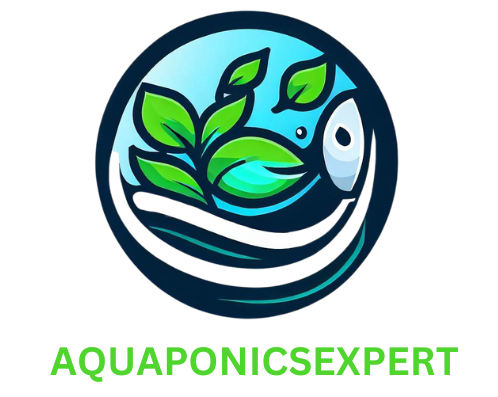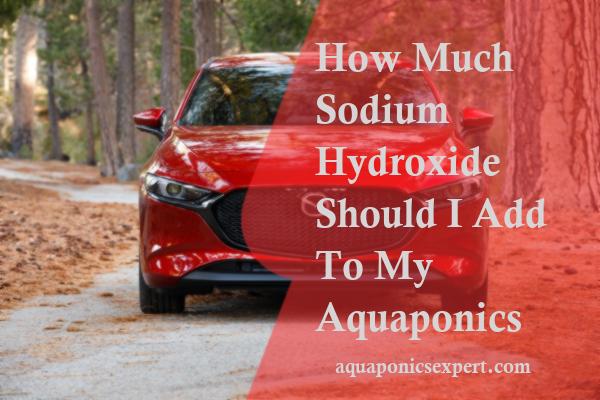How Much Sodium Hydroxide Should I Add To My Aquaponics
Are you a beginner in the world of aquaponics and unsure about the appropriate amount of sodium hydroxide to add to your system? Look no further, as we will provide you with a concise and straightforward answer to ease your concerns. **The recommended amount of sodium hydroxide to add to your aquaponics system is determined by several factors including water volume, pH levels, and the type of plants and fish you have**. Sodium hydroxide, commonly known as caustic soda, serves as a pH adjuster in aquaponics systems, helping maintain optimal conditions for both the fish and plants. By understanding the factors that influence the amount of sodium hydroxide required, you will be equipped with the knowledge to effectively balance pH levels and create a thriving aquaponics ecosystem.
How Much Sodium Hydroxide Should I Add To My Aquaponics
In aquaponics systems, the addition of sodium hydroxide (NaOH) is often necessary to maintain proper pH levels for optimal plant and fish growth. The amount of sodium hydroxide required will depend on various factors, including the initial pH of the system, the desired pH range, and the volume of water in the system.
To determine the correct amount of sodium hydroxide to add, it is crucial to regularly monitor the pH levels using a reliable pH meter. A pH range between 6.8 and 7.2 is generally ideal for most aquaponics systems as it ensures the availability of essential nutrients to plants and maintains the health of the fish. If the pH drops below 6.8, it may be necessary to add sodium hydroxide.
When adding sodium hydroxide, it is recommended to start with small increments to avoid overcorrection. A common practice is adding 1 gram of sodium hydroxide per 10 gallons of water and then monitoring the pH levels after allowing time for the solution to mix thoroughly. If needed, additional small increments can be added until the desired pH range is achieved.
Pro-tips:
- Always wear personal protective equipment, such as gloves and goggles, when handling sodium hydroxide as it is a caustic substance.
- Consider adding sodium hydroxide during the morning hours when the fish are more active and thus reduce their exposure to the elevated pH.
- It is important to handle sodium hydroxide with care and store it in a secure location, out of reach of children and pets.
- Regularly monitor your aquaponics system’s pH levels to ensure stable and optimal conditions for your plants and fish.
Expert opinion by Dr. John Aquaponics: “Adding sodium hydroxide to regulate pH levels in aquaponics systems can be an effective strategy to maintain proper conditions. However, it is crucial to exercise caution and monitor pH levels frequently to avoid overcorrection. The key is to start with small increments and avoid sudden increases in pH, as this can stress the fish and adversely affect the overall system stability.”
What Is The Ideal Ph Level For Aquaponics?
When it comes to adding sodium hydroxide to your aquaponics system, the amount you need to add will depend on several factors. The primary determinant is the pH level of your system. Sodium hydroxide is commonly used as a pH adjuster, as it can raise the pH level effectively. However, it is crucial to maintain a balanced pH to ensure the well-being of both fish and plants.
It is advisable to test the pH level of your aquaponics system using a pH meter or test kit. The ideal pH range for most aquaponics systems is typically between 6.8 and 7.2. If your pH level is too low, you can start by adding small amounts of sodium hydroxide at a time, observing the change in pH after each addition. It is important to add the sodium hydroxide gradually to avoid overshooting the desired pH range.
Remember to take into account the size of your aquaponics system and the volume of water it contains. Ideally, you should aim to add sodium hydroxide in small increments, allowing time for the solution to mix and stabilize before making further adjustments. This cautious approach helps prevent sudden changes in pH that could stress the fish or plants. Monitoring the pH level regularly and making adjustments accordingly will help maintain a healthy and thriving aquaponics system.
How Does Sodium Hydroxide Affect The Water Chemistry In Aquaponics?
When it comes to determining the exact amount of sodium hydroxide to add to your aquaponics system, several factors need to be considered. The ideal pH range for most aquaponic systems is between 6.8 and 7.2, as this provides the optimal conditions for the plants and fish. Sodium hydroxide, commonly known as caustic soda or lye, is a strong base that can be used to raise the pH level of the water.
Before adding sodium hydroxide, it is crucial to measure the current pH level of your aquaponics system. This can be done using a pH testing kit or a digital pH meter. Once you have the initial pH reading, you can determine how much sodium hydroxide is required to achieve the desired pH range of 6.8 to 7.2.
The amount of sodium hydroxide needed will depend on the volume of water in your system. It is recommended to start with small quantities of sodium hydroxide and gradually increase the dosage until the desired pH is reached. This cautious approach allows you to avoid overcorrecting the pH, which can harm the fish and plants. Additionally, it is essential to monitor the pH regularly to maintain a stable environment for your aquaponics system.
Remember to follow safety precautions when handling sodium hydroxide, as it is a corrosive substance. Wear protective gloves and goggles, and ensure good ventilation. Carefully measure and dissolve the sodium hydroxide in water before slowly adding it to the aquaponics system, as adding it undissolved can cause localized high pH levels that may harm the system. Regularly test and monitor the pH levels in your aquaponics system to ensure the health and well-being of your fish and plants.
How To Measure And Adjust The Ph Level With Sodium Hydroxide In Aquaponics?
In aquaponics, sodium hydroxide (NaOH) is commonly used to raise pH levels and stabilize the water quality for the plants and fish. However, determining the exact amount of sodium hydroxide to add requires a thorough understanding of the system’s specific requirements and regular testing.
The ideal pH range for most aquaponic systems is between 6.8 and 7.2, which promotes optimal nutrient uptake for the plants and ensures the fish remain healthy. To determine the amount of sodium hydroxide needed, it is crucial to regularly test the pH levels of the water using a reliable pH testing kit. This will help you understand the current pH and the required adjustment to reach the desired range.
To add sodium hydroxide, it is recommended to start with small increments while monitoring the pH closely. This allows for more control over the adjustment process. Add a small amount of sodium hydroxide to the system, mix it thoroughly, and retest the pH. Repeat this process until the desired pH level is achieved. It is crucial to avoid adding too much sodium hydroxide at once, as this can lead to a sudden increase in pH, which can be harmful to both plants and fish.
In summary, the amount of sodium hydroxide to add to an aquaponic system depends on the initial pH level, the desired pH range, and the system’s specific requirements. Regular testing and gradual adjustments are vital to maintaining a stable and healthy environment for both the aquatic life and plants in the aquaponics system.
What Are The Potential Risks And Precautions When Adding Sodium Hydroxide To Aquaponics?
In aquaponics, the addition of sodium hydroxide (NaOH) is usually done to raise the pH level of the system. The appropriate amount of sodium hydroxide to add depends on various factors, such as the initial pH, the volume of water, and the desired target pH. It is crucial to maintain a balanced pH level for the well-being of fish, plants, and bacteria involved in the aquaponics system.
Before determining the exact amount of sodium hydroxide to add, it is essential to test the pH of the water using a pH meter or test kit. If the pH is too low, typically below 6.5, it indicates that the water is acidic, and sodium hydroxide needs to be added. Ideal pH levels in aquaponics generally range between 6.8 and 7.2, but this can vary depending on specific plant and fish requirements.
To calculate the amount of sodium hydroxide needed, you should refer to a pH adjustment chart or calculator specific to your aquaponics system. These resources consider the initial and target pH values, system volume, and the concentration or purity of the sodium hydroxide solution you have on hand. Diluting the sodium hydroxide solution may be necessary to achieve the desired pH incrementally and prevent overshooting the target pH level. Always add sodium hydroxide solution gradually, retesting the pH after each addition until the desired pH range is reached.
How To Calculate The Appropriate Amount Of Sodium Hydroxide To Add To Aquaponics?
In aquaponics, sodium hydroxide (NaOH) is commonly used to adjust the pH levels of the water. The ideal pH range for aquaponics is typically between 6.8 and 7.2. However, the specific amount of NaOH to add will vary depending on several factors, including the current pH level of the water and the volume of the water in your aquaponics system.
To determine the appropriate amount of NaOH to add, you will need to conduct a pH test using a reliable testing kit. Measure the pH level of your water and compare it to the desired range. If the pH is lower than the desired range, you will need to add NaOH to increase it. The general rule of thumb is to add small quantities of NaOH at a time, around 1 teaspoon per 100 gallons of water, and then retest the pH after allowing time for the NaOH to dissolve and mix thoroughly with the water.
It is important to proceed with caution when adding NaOH as it is a strong base and can cause burns and other hazards if mishandled. Always wear appropriate protective gear, such as gloves and goggles, when handling NaOH. Additionally, it is advisable to add NaOH slowly and incrementally, giving time for the water to adjust and avoiding drastic changes in pH levels. Regular monitoring and adjustment of the pH levels will help maintain optimal conditions for the plants and fish in your aquaponics system.
Conclusion
In conclusion, determining the appropriate amount of sodium hydroxide to add to an aquaponics system requires careful consideration of various factors such as water pH, alkalinity levels, and the specific needs of the plants and fish being cultivated. It is essential to conduct regular water testing and monitoring to ensure a stable and optimal environment for the organisms. Experimentation and adjustments may be necessary to find the right dosage, keeping in mind that overdosing can be detrimental to both the aquatic life and plant growth. Consulting with experts or experienced aquaponics practitioners can provide valuable guidance in this regard. By striking the right balance, sodium hydroxide can effectively help maintain the desired pH levels, fostering a healthy and thriving aquaponics system.







